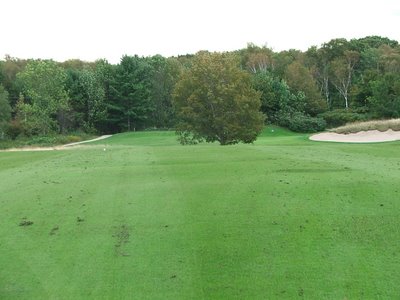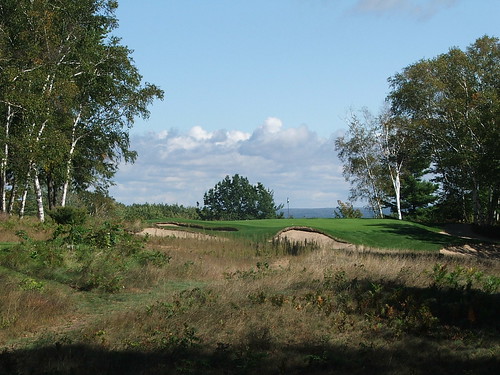 View from the 1st tee
View from the 1st teeThe architect that has designed the most courses on the top 100 list is Alister Mackenzie. Oddly enough, although I have played 54 courses I have not yet played a Mackenzie. Many of the courses he designed are in Australia and I have not yet made the journey. His other U.S. courses, Cypress Point, The Valley Club of Montecito and Augusta are on the difficult side to get on, shall we say?
My first exposure to Dr. Mackenzie is the Crystal Downs Country Club (ranked #24 in the world). Crystal Downs is located in Northern Michigan, not far from Traverse City in the town of Frankfort. The course was founded in 1927 and completed in 1929. Dr. Mackenzie worked with Perry Maxwell on the design and construction of the course.
The terrain that Crystal Downs is built on is hilly. Very hilly. The picture below can give you some appreciation for the terrain. I would say that thus far, the only other course I have played that compares to it in terms of the amount of hills is The Olympic Club. At times when walking Crystal Downs you feel like a billy goat. The course was co-designed by Perry Maxwell who also designed Southern Hills and Prairie Dunes, both of which I played within the last two months. I also see a lot of similarities between the fairways at Prairie Dunes and those at Crystal Downs. It looks like Maxwell had a lot of influence on the fairways and Mackenzie had a greater influence on the greens.

I have recently completed reading
Dream Golf by Steve Goodwin which is about the building of the Bandon Dunes resort (I highly recommend the book). One of Goodwin's observations is that architects tend to design courses that favor their game. Nicklaus builds long courses, Charles Blair Macdonald built courses that favored a slicer and Mackenzie designed courses with challenging greens because he was a good putter. The greens at Crystal Downs are difficult enough because the course is built among the hills. The undulations and contouring that Mackenzie and Maxwell added in make them very challenging indeed. One of the things you discover very quickly playing Crystal Downs is that there is a premium placed on putting well. I had better sharpen up my putter for the other 10 Mackenzie courses on the list.

5th hole blind shot to the green
Crystal Downs also reconfirmed what I have always felt, that blind shots are an integral part of the game and far from representing tricked up holes, are found throughout the top 100 courses, including several holes at Crystal Downs.
I found another hole to add to my list of unique and great golf holes in the world. The 7th hole pictured below has a tree in front of the green in the middle of the fairway. A well struck tee shot in the fairway requires you to hit over the tree onto a small undulating green. At 335 yards, you only have a short iron to the green, so it's a fair shot and genuine fun.
 7th hole fairway looking toward green (behind tree)
7th hole fairway looking toward green (behind tree)
The next hole, the 8th, on the other hand is a patently unfair hole. Clearly the #1 handicap hole on the course, and by a lot. Sometimes an architect can go too far and I feel that they did so on this hole. The hole is a 550 yard par five that plays uphill, uphill and then uphill with wild slopes throughout the fairway. The green slopes from back to front and is very difficult to hold. Once on the green, it is too fast to hold putts. Every golfer in our group putted off the green. To me, this is too much.
After you complete the front nine you tee off on the 10th tee right next to the clubhouse with a large picture window near the grill area of the clubhouse. The land is built up so that you are standing slightly above the table level of the golfers sitting inside. They are about three feet away from you, but behind glass. You have a tee shot that is gloriously downhill. It is a unique and fine setup and unlike anything I've seen before.
Transported in space and time
Against the advice of the pro we walked the course. Almost everyone else on the course was riding. It turned out to be a very demanding course to walk. After playing the 11th hole at Crystal Downs, you literally take a hike through the woods. It takes you several minutes to walk to the next tee box. The walk is uphill and idyllic and you are wonderfully isolated. I was not prepared for what we found on the 12th tee box. We were winded when we reached the tee and sat on a bench on the tee box. It is one of the special places in the world of golf.
Walking through that forest could have been the equivalent of flying across the Atlantic Ocean. The next five holes may as well be at Sunningdale or Walton Heath. The character of the terrain completely changes, the course becomes relatively flat and the mix of plants and trees is reminiscent of the heathlands around London. Lots of silver birch trees, fescue, some heather, etc.
The next five holes are as good as it gets; peaceful and isolated. You can occasionally glimpse Lake Michigan through the trees. We became giddy with excitement as we played this stretch of holes. A fine mix of long and short holes with challenging greens. World class.

The 14th, par 3, from the tee
You re-emerge from the forest after walking off the 16th green and return to the real world. The 17th and 18th holes return to the hilly character that the first 11 holes had, making this unique stretch of holes (12-16) even more special.
I also experienced the Mackenzie camouflage effect at Crystal Downs. I didn't find that I hit into many of the bunkers, but their presence really causes you to aim your shots in the wrong direction in a subtle way. On the 12th hole the tree that appears to be in the middle-to-right side of the fairway from the tee is amazingly on the left side of the fairway when you get up to it. On the 4th, 5th and 6th tee shots you almost don't know where to aim off the tee, there is such a mix of trees, bunkers, severe hills and native grasses.
How is it that Dr. Mackenzie got a commission to design a golf course in Northern Michigan in the 1927? Tom Doak, a Michigan resident and member of Crystal Downs, by the way, in his excellent book The Life and Work of Dr. Alister Mackenzie, tells the story. The men that wanted to build a course wrote to Robert Hunter who had just written a book about golf course architecture. It turned out to be a prescient move. Hunter did design work with Mackenzie and recommended him for the job. In a stroke of luck we should all now be thankful for, it turns out Mackenzie was completing his design of Cypress Point and had to make the journey across the U.S. to make his way back to England. He met up with Perry Maxwell en route (Maxwell did a lot of work in the lower midwest) and they made the trip up to Michigan. Mackenzie first met Maxwell a tour of the British Isles in 1923 and Maxwell told him to look him up if he ever came over to the States. Once again, the stars seemed to align for the creation of this great golf course. Upon seeing the land, Mackenzie said that in England they would call this type of land "downs". Since the course overlooks Crystal Lake, the course was named Crystal Downs.
Apparently Mackenzie designed the front nine and then left Maxwell in charge of the construction. Mackenzie made Maxwell his partner "East of the Mississippi" according to his company's letterhead. In any event, the front nine is the clearly harder of the two nines with more difficult greens. Maxwell apparently designed and built the back nine two years later. It's no wonder Doak named his golf course design firm Renaissance. He is indeed a renaissance man, being both a world class designer and a fantastic author.
I have always found people from Michigan staunchly defend and love their home state, almost more so than any other state in the Union. They are hugely supportive of their sports teams, especially their college football teams. Many live there, vacation there and then retire there. It's nice to see such pride in a place. I am happy to report that their pride of place is completely justified at Crystal Downs. It justly deserves its world ranking as one of the best golf courses in the world.
 The 3rd hole at Morfontaine
The 3rd hole at Morfontaine The clubhouse at Morfontaine
The clubhouse at Morfontaine



